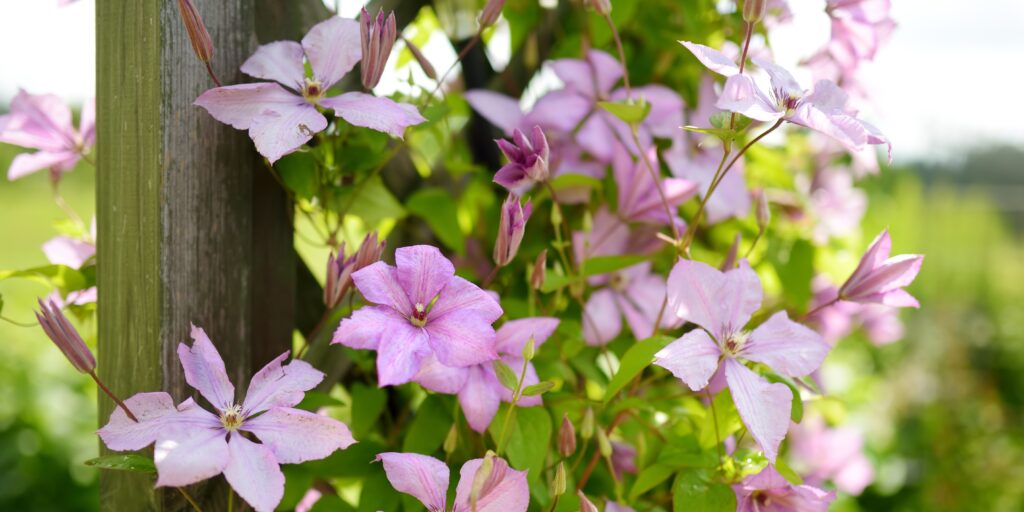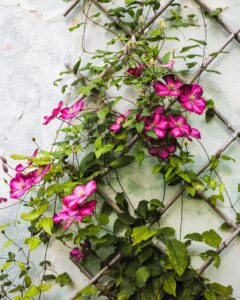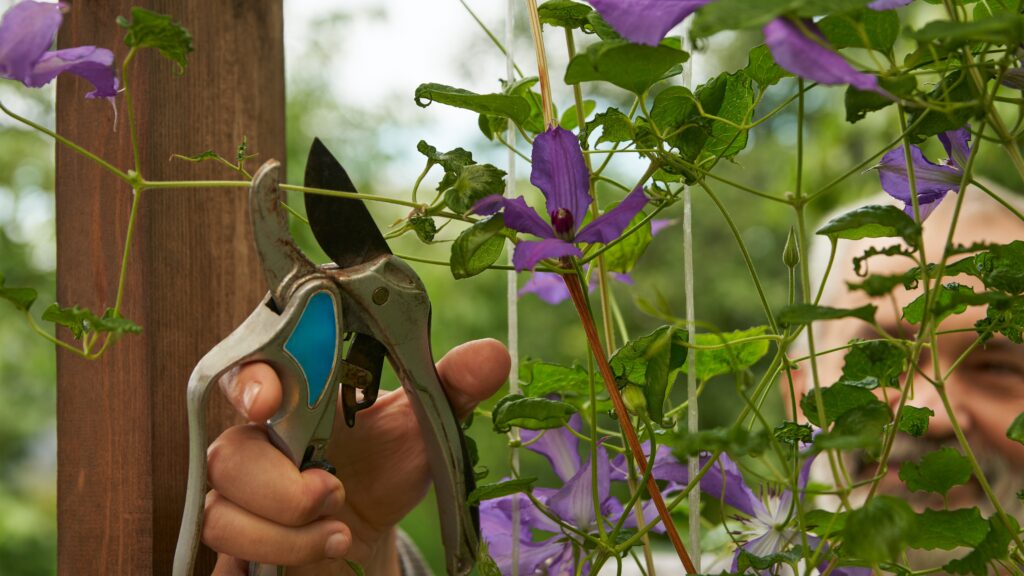May 26, 2025
Clematis 101: Choosing, Growing & Pruning the Queen of Climbers
There’s a reason clematis is known as the “Queen of Climbers.” With gorgeous, showy blooms in a rainbow of colors and a long flowering season, this versatile vine adds vertical interest and charm to any garden. Whether you’re looking to cover a trellis, fence, mailbox, or obelisk, these plants can do it all—but choosing the right variety and understanding how to prune it are key to success.

Sun or Shade? There’s a Clematis for That
Most clematis varieties thrive in full sun (about 6 hours of sunlight per day), but they like their roots cool and shaded. This classic combo—“head in the sun, feet in the shade”—can be achieved by planting low-growing perennials, groundcovers, or even a small shrub around the base.
If you’re working with a part-shade location, don’t worry—there are varieties that can bloom beautifully without full sun. Look for types like Clematis alpina, Clematis montana, or the shade-tolerant ‘Nelly Moser’, which performs especially well with morning sun and afternoon shade.

Clematis ‘Jackmanii’
Picking the Right Variety
Here in Massachusetts (zones 5–7), many varieties are winter-hardy and well-suited to our seasons. Some favorites include:
- ‘Jackmanii’ – A classic with deep purple blooms; thrives in full sun and blooms mid to late summer.
- ‘Nelly Moser’ – Pale pink with a rosy stripe; prefers part-shade and blooms in spring with a second flush in late summer.
- ‘Sweet Autumn’ (terniflora) – A vigorous late bloomer with fragrant white flowers in late summer to early fall.
- ‘Dr. Ruppel’ – Large pink blooms with dark pink stripes; reblooms well and tolerates part sun.
Don’t Have a Trellis? Try a Bush or Groundcover Clematis
While most clematis are natural climbers, there are some beautiful non-vining varieties that grow more like small shrubs or trailing groundcovers. These are perfect for gardeners who don’t have space for a trellis, arbor, or fence—or simply want to try something different.
Non-climbing clematis options include:
- Clematis ‘Arabella’ – A long-blooming variety with rich lavender-blue flowers. This one sprawls more than climbs and looks great spilling over a wall or container.
- Clematis ‘Heracleifolia’ (Tube Clematis) – A true bush-type clematis with a sturdy, upright habit and clusters of fragrant, hyacinth-like blooms.
- Clematis integrifolia – A compact, herbaceous clematis with nodding blue or purple bell-shaped flowers. It grows upright and needs little to no support.
These types are ideal for borders, containers, or even draping over rocks. Just be sure to give them good soil, sunlight, and a little space to sprawl.
Understanding Clematis Pruning Groups
One of the most common questions we hear at the garden center is: When should I prune my clematis? The answer depends on which pruning group your clematis belongs to. There are three main groups, and every clematis variety falls into one of them.
Group 1: Early Bloomers (Spring Blooming on Old Wood)
Examples: Clematis montana, Clematis alpina
- When to prune: Right after flowering (late spring to early summer)
- Why: These bloom on last year’s growth, so cutting them back in spring will remove flower buds.
- How: Light shaping and deadwood removal is all that’s needed.
Group 2: Repeat Bloomers (Spring & Summer Blooming on Old and New Wood)
Examples: Nelly Moser, Dr. Ruppel, Henryi
- When to prune: Late winter or early spring (February–March)
- Why: These bloom first on old wood, then again on new wood later in the season.
- How: Remove dead or weak stems, and lightly shape the rest. Try not to cut too hard or you’ll reduce the first flush of blooms.
Group 3: Summer/Fall Bloomers (Blooms on New Wood)
Examples: Jackmanii, Sweet Autumn Clematis, as well as non-vining clematis
- When to prune: Late winter to early spring (February–March)
- Why: These only bloom on new growth, so a hard prune encourages lots of fresh flowering stems.
- How: Cut all stems back to 6–12 inches from the ground.
 Pro Tips for Clematis Success
Pro Tips for Clematis Success
- Support matters: Clematis love to climb, but their leaf stems need something thin to wrap around. Use a trellis with narrow slats, netting, or wire.
- Water deeply: Especially during the first growing season. Clematis like moist but well-draining soil.
- Fertilize in spring: Use a balanced fertilizer to support healthy growth and flower production.
Plant Once, Enjoy for Years
Once established, clematis can live for decades, getting stronger and more beautiful each year. With the right care—and a little pruning know-how—you’ll enjoy a spectacular display year after year. An adage that we love: First year it sleeps, second year it creeps, third year it leaps!
Stop by any of our Mahoney’s locations to explore our clematis selection and let our expert staff help you choose the perfect variety for your space, or check out online store!

